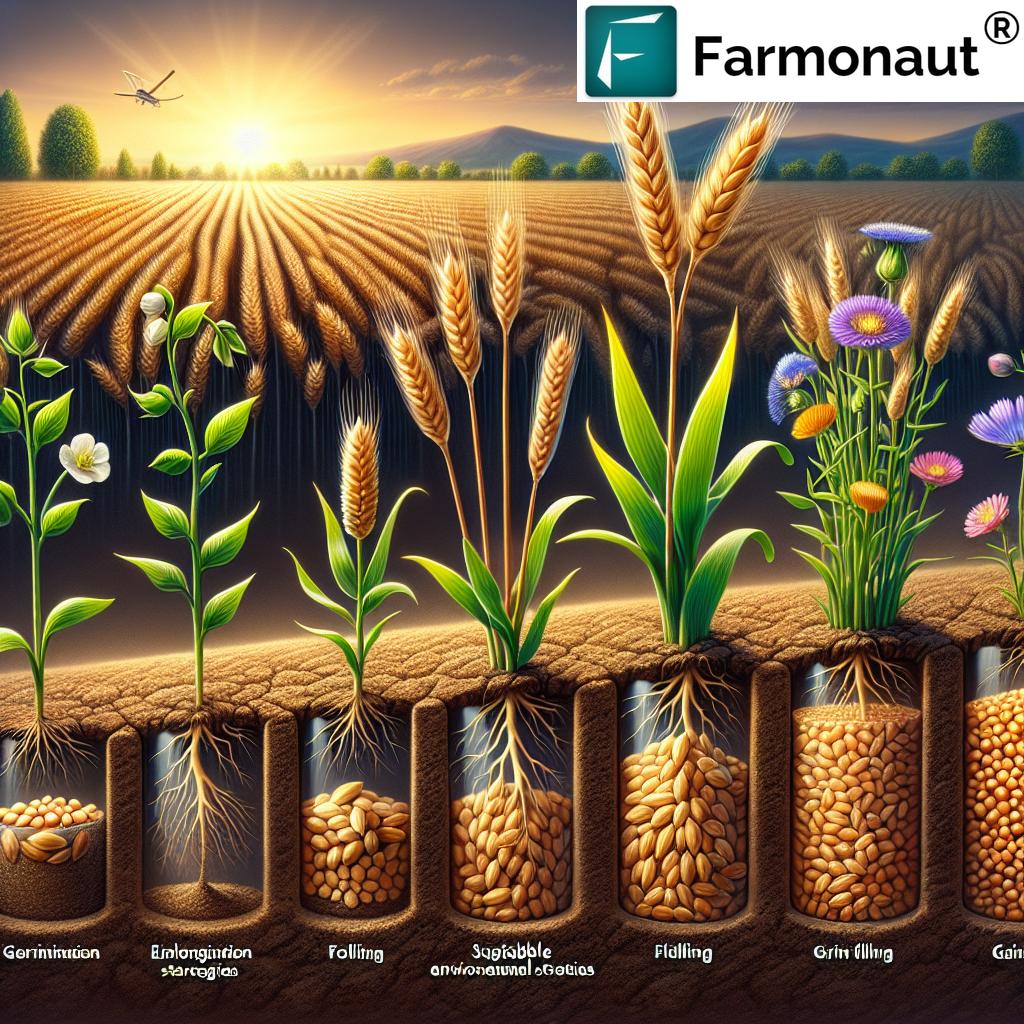Understanding Zinc Deficiency in Plants: Symptoms, Solutions, and Impact on Growth

As agricultural experts and innovators at Farmonaut, we understand the critical role that micronutrients play in plant health and development. Among these essential elements, zinc stands out as a vital component for numerous plant functions. In this comprehensive guide, we’ll delve deep into the world of zinc deficiency in plants, exploring its symptoms, organic and conventional solutions, and the significant impact it has on plant growth and development.
The Importance of Zinc in Plant Nutrition
Zinc is a crucial micronutrient that plays a pivotal role in various plant processes. Its importance cannot be overstated, as it is involved in:
- Enzyme activation and production
- Protein synthesis
- Hormone regulation
- Chlorophyll formation
- Carbohydrate metabolism
- Stress tolerance
Despite its significance, zinc deficiency is a common problem in many agricultural regions worldwide. Understanding the symptoms and implementing effective solutions is crucial for maintaining healthy crops and optimizing yields.
Identifying Zinc Deficiency Symptoms
Recognizing the signs of zinc deficiency early is key to preventing severe crop damage. The symptoms can vary depending on the plant species, but some common indicators include:
- Chlorosis: Yellowing between the veins of young leaves is often one of the first signs of zinc deficiency. This interveinal chlorosis can be easily mistaken for iron deficiency, so careful observation is necessary.
- Stunted Growth: Plants suffering from zinc deficiency often exhibit reduced internodal length, resulting in a rosette-like appearance in severe cases.
- Leaf Deformities: Leaves may become small, narrow, and distorted. In some cases, they may develop a “little leaf” syndrome.
- Bronzing: Advanced zinc deficiency can lead to bronzing of leaves, where they develop a bronze or brown coloration.
- Necrotic Spots: In severe cases, necrotic spots may appear on older leaves, indicating tissue death.
- Delayed Maturity: Zinc-deficient plants often show delayed maturity, affecting overall crop development and yield.

The Impact of Zinc Deficiency on Plant Growth and Development
Zinc deficiency can have far-reaching consequences on plant growth and development. As a crucial component in various plant processes, inadequate zinc levels can lead to:
- Reduced photosynthesis efficiency
- Impaired protein synthesis
- Decreased production of growth hormones
- Weakened cell wall structure
- Increased susceptibility to pests and diseases
- Lower crop yields and quality
These effects collectively contribute to significant economic losses for farmers and can impact food security on a broader scale.
Factors Contributing to Zinc Deficiency
Understanding the causes of zinc deficiency is crucial for implementing effective prevention and management strategies. Several factors can contribute to zinc deficiency in plants:
- Soil pH: High soil pH (alkaline soils) can reduce zinc availability to plants.
- Soil Type: Sandy soils and soils low in organic matter are more prone to zinc deficiency.
- High Phosphorus Levels: Excessive phosphorus in the soil can interfere with zinc uptake.
- Cold, Wet Conditions: These conditions can reduce zinc availability and root growth.
- Intensive Cropping: Continuous cropping without proper nutrient management can deplete soil zinc reserves.
- Genetic Factors: Some plant varieties are more efficient at zinc uptake than others.
Organic Solutions for Zinc Deficiency
At Farmonaut, we advocate for sustainable farming practices, including organic solutions to nutrient deficiencies. Here are some effective organic methods to address zinc deficiency:
- Organic Matter Addition: Incorporating compost, manure, or other organic materials can improve soil structure and increase zinc availability.
- Green Manures: Planting and incorporating zinc-accumulating cover crops can help recycle zinc in the soil.
- Organic Zinc Fertilizers: Products like zinc lignosulfonate or zinc amino acid chelates are organic-approved zinc sources.
- Foliar Sprays: Organic zinc solutions can be applied directly to leaves for quick absorption.
- Crop Rotation: Rotating crops with different nutrient requirements can help maintain soil zinc levels.
- pH Management: Using organic methods to maintain optimal soil pH can improve zinc availability.
Conventional Approaches to Zinc Deficiency Management
While we prioritize organic solutions, it’s important to understand conventional methods for managing zinc deficiency:
- Zinc Sulfate Application: Zinc sulfate is a commonly used inorganic zinc fertilizer that can be applied to soil or as a foliar spray.
- Chelated Zinc Products: These formulations provide zinc in a form that’s more readily available to plants.
- Seed Treatment: Coating seeds with zinc can provide early-stage nutrition to seedlings.
- Soil Testing and Targeted Application: Regular soil testing allows for precise zinc application based on actual soil needs.
- Balanced Fertilization: Ensuring a proper balance of all nutrients can prevent zinc deficiency induced by other nutrient imbalances.
Integrating Technology for Efficient Zinc Deficiency Management
At Farmonaut, we leverage cutting-edge technology to enhance nutrient management strategies, including addressing zinc deficiency. Our satellite-based crop monitoring system offers several advantages:
- Early Detection: Our advanced imaging technology can identify signs of zinc deficiency before they become visible to the naked eye.
- Large-Scale Monitoring: We can efficiently monitor vast agricultural areas, providing a comprehensive view of crop health.
- Precision Application: By identifying specific areas of deficiency, we enable targeted zinc application, reducing waste and improving efficiency.
- Historical Data Analysis: Our system allows for the comparison of current crop health with historical data, helping identify recurring zinc deficiency patterns.
- Integration with Other Data: We combine satellite imagery with soil test results and weather data for a holistic approach to nutrient management.
To illustrate the advantages of our technology, let’s compare traditional methods with the Farmonaut Satellite System for zinc deficiency detection:
| Aspect | Traditional Method | Farmonaut Satellite System |
|---|---|---|
| Detection Speed | Slow (Manual field inspections) | Rapid (Large area coverage in minutes) |
| Labor Requirement | High | Low |
| Accuracy | Variable (Dependent on inspector’s expertise) | High (Consistent, data-driven analysis) |
| Early Detection | Limited (Visual symptoms only) | Advanced (Pre-visual symptom detection) |
| Cost-Effectiveness | Low (Time and labor-intensive) | High (Efficient, scalable solution) |
| Data Integration | Manual (Prone to errors) | Automated (Seamless integration with other farm data) |
As evident from the comparison, the Farmonaut Satellite System offers significant advantages in terms of speed, accuracy, and cost-effectiveness in detecting and managing zinc deficiency across large agricultural areas.
The Role of Zinc in Plant Protection and Pest Control
Zinc plays a crucial role in plant protection and natural pest control mechanisms. Adequate zinc levels contribute to:
- Enhanced Cell Wall Strength: This provides a physical barrier against pathogen invasion.
- Improved Immune Response: Zinc is involved in the production of defensive compounds.
- Increased Tolerance to Environmental Stresses: This indirectly reduces plant susceptibility to pests and diseases.
- Better Overall Plant Health: Well-nourished plants are generally more resistant to pest attacks.
By ensuring optimal zinc nutrition, farmers can reduce their reliance on chemical pesticides, aligning with both organic and integrated pest management strategies.
Zinc’s Interaction with Other Nutrients
Understanding the interplay between zinc and other nutrients is crucial for effective plant nutrition management. Some key interactions include:
- Zinc and Phosphorus: High phosphorus levels can induce zinc deficiency, necessitating careful balance.
- Zinc and Iron: These micronutrients can compete for uptake, and their deficiency symptoms are often similar.
- Zinc and Nitrogen: Adequate zinc is necessary for efficient nitrogen use in plants.
- Zinc and Copper: These elements can antagonize each other’s uptake if present in imbalanced ratios.
At Farmonaut, our advanced nutrient management tools take these interactions into account, providing farmers with holistic nutrition strategies that optimize overall plant health.
The Future of Zinc Management in Agriculture
As we look to the future, several trends and innovations are shaping the landscape of zinc management in agriculture:
- Biofortification: Development of crop varieties with enhanced zinc uptake and accumulation capabilities.
- Nanotechnology: Use of zinc nanoparticles for more efficient nutrient delivery.
- Precision Agriculture: Integration of GPS, drone technology, and AI for ultra-precise zinc application.
- Soil Microbiome Management: Enhancing beneficial soil microorganisms that improve zinc availability.
- Climate-Smart Zinc Management: Developing strategies to maintain zinc nutrition under changing climate conditions.
At Farmonaut, we’re at the forefront of these innovations, continuously updating our platform to incorporate the latest advancements in agricultural science and technology.
Implementing a Comprehensive Zinc Management Strategy
To effectively address zinc deficiency and optimize plant nutrition, we recommend a multi-faceted approach:
- Regular Soil Testing: Conduct comprehensive soil analyses to determine zinc levels and other nutrient interactions.
- Crop Monitoring: Utilize Farmonaut’s satellite-based crop monitoring system for early detection of zinc deficiency symptoms.
- Balanced Fertilization: Implement a holistic nutrient management plan that considers all macro and micronutrients.
- Integrated Approach: Combine organic and conventional methods as appropriate for your farming system.
- Preventive Measures: Address soil pH and organic matter content to improve overall zinc availability.
- Timely Intervention: Apply zinc supplements at critical growth stages when demand is highest.
- Continuous Learning: Stay informed about the latest research and technologies in zinc nutrition management.
By following these steps and leveraging Farmonaut’s advanced agricultural technologies, farmers can effectively manage zinc nutrition, leading to healthier crops, higher yields, and more sustainable farming practices.
Conclusion
Zinc deficiency is a significant challenge in modern agriculture, but with the right knowledge, tools, and strategies, it can be effectively managed. At Farmonaut, we’re committed to empowering farmers with cutting-edge technologies and comprehensive solutions to address nutrient deficiencies and optimize crop health.
By understanding the symptoms of zinc deficiency, implementing both organic and conventional solutions, and leveraging advanced monitoring technologies, farmers can ensure their crops receive the optimal zinc nutrition they need for robust growth and development.
As we continue to face global challenges in food security and sustainable agriculture, effective micronutrient management, including zinc, will play an increasingly crucial role. With innovative approaches and technologies, we can work together to build a more resilient and productive agricultural future.
For more information on how Farmonaut can help you optimize your crop’s zinc nutrition and overall health, visit our website or download our app:
For developers interested in integrating our advanced agricultural data into their own systems, check out our API documentation:
FAQs about Zinc Deficiency in Plants
- Q: How quickly can zinc deficiency symptoms appear in plants?
A: Symptoms can appear within a few weeks of zinc becoming limiting, especially in young, rapidly growing tissues. - Q: Can excessive zinc application be harmful to plants?
A: Yes, while zinc is essential, excessive application can lead to toxicity symptoms and interfere with the uptake of other nutrients. - Q: Are some crops more susceptible to zinc deficiency than others?
A: Yes, crops like corn, rice, beans, and citrus fruits are generally more sensitive to zinc deficiency. - Q: How does soil pH affect zinc availability?
A: Zinc availability decreases in alkaline soils (high pH). It’s most available to plants when soil pH is between 5.5 and 6.5. - Q: Can foliar application of zinc correct deficiency faster than soil application?
A: Yes, foliar application can provide a quicker response, especially for addressing acute deficiencies during critical growth stages. - Q: How does organic farming address zinc deficiency without synthetic fertilizers?
A: Organic farmers use methods like adding organic matter, using approved organic zinc supplements, and crop rotation to manage zinc nutrition. - Q: Can zinc deficiency be confused with other nutrient deficiencies?
A: Yes, zinc deficiency symptoms can be similar to iron or manganese deficiency. Accurate diagnosis often requires soil and tissue testing. - Q: How does climate change impact zinc availability in soils?
A: Climate change can affect soil zinc availability through changes in soil moisture, temperature, and carbon dioxide levels, potentially exacerbating deficiencies in some regions. - Q: Are there any natural zinc accumulators that can be used in crop rotation?
A: Yes, certain legumes and cereal crops like wheat and barley are efficient zinc accumulators and can be used in rotation to improve soil zinc status. - Q: How often should soil be tested for zinc levels?
A: Generally, soil should be tested every 2-3 years, but annual testing may be necessary in areas prone to zinc deficiency or under intensive cropping systems.












